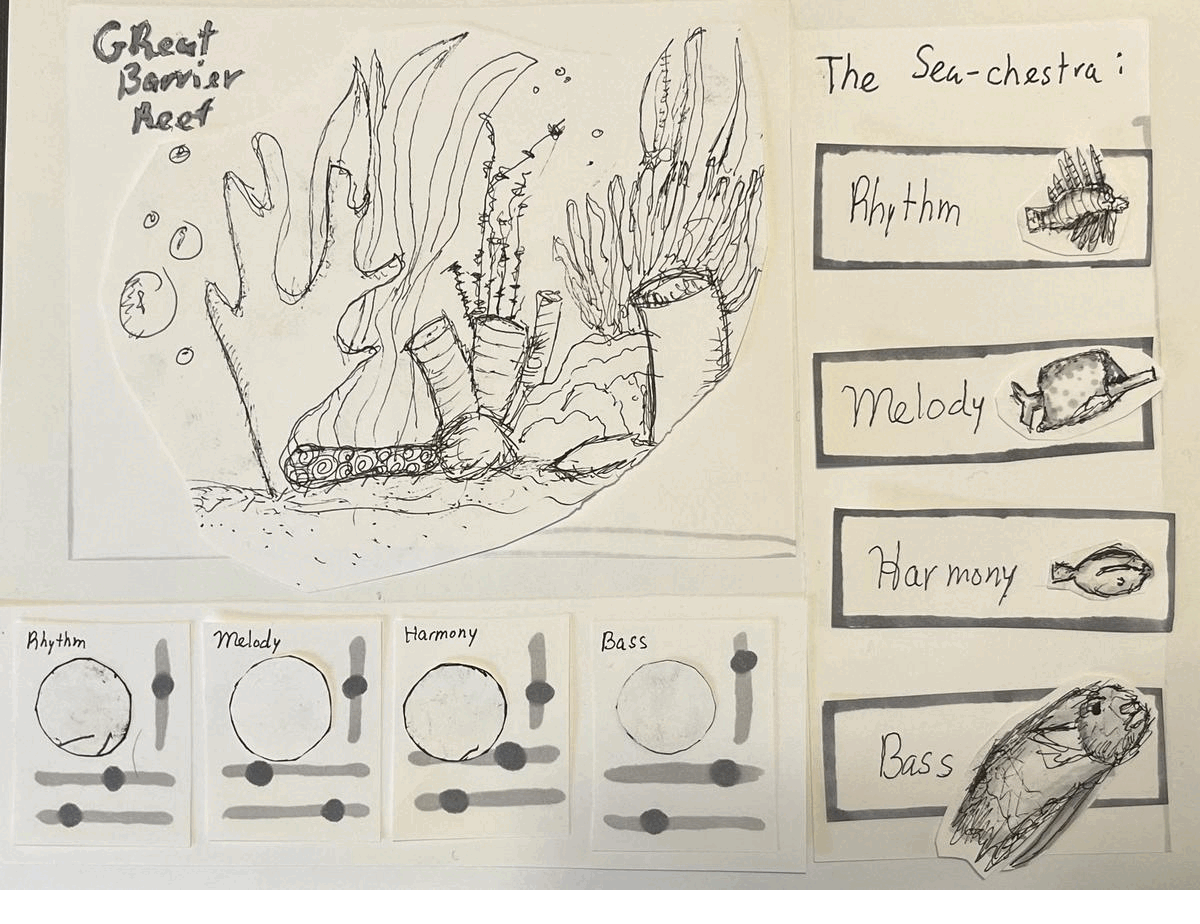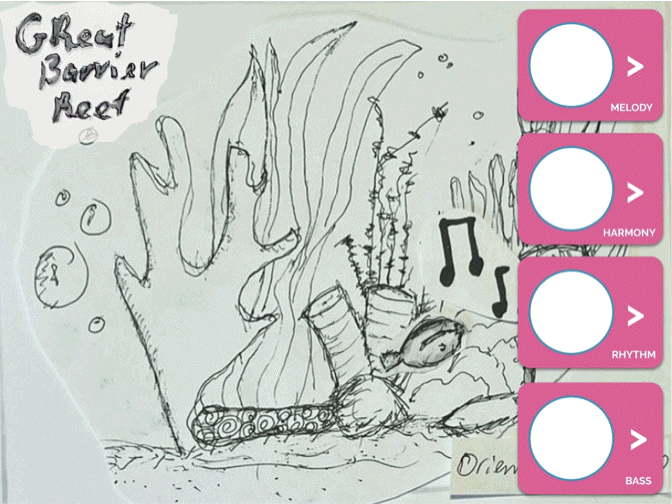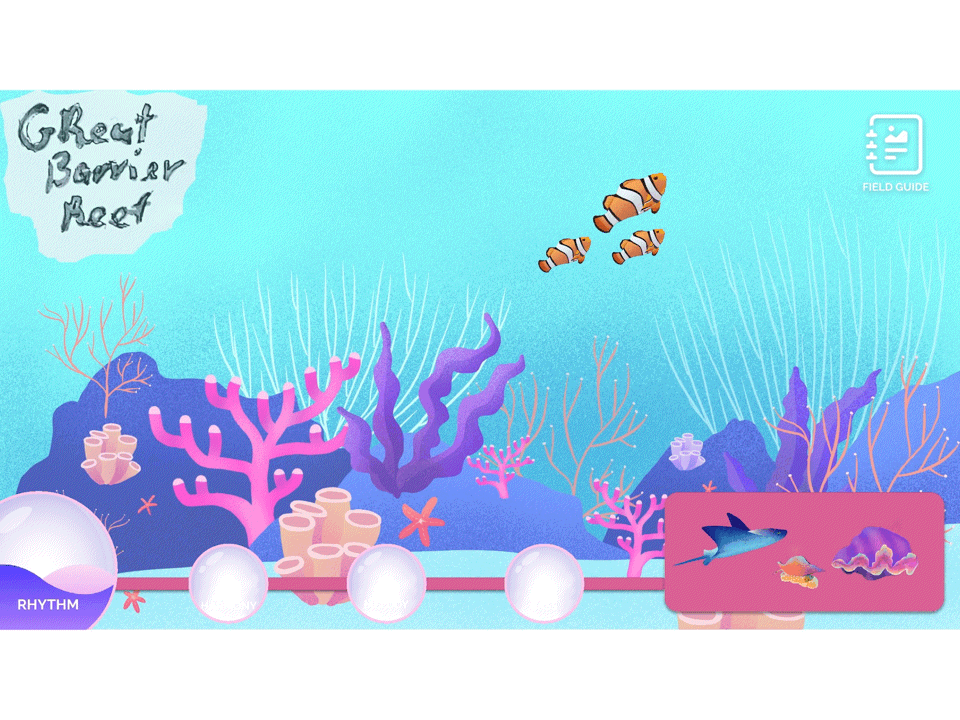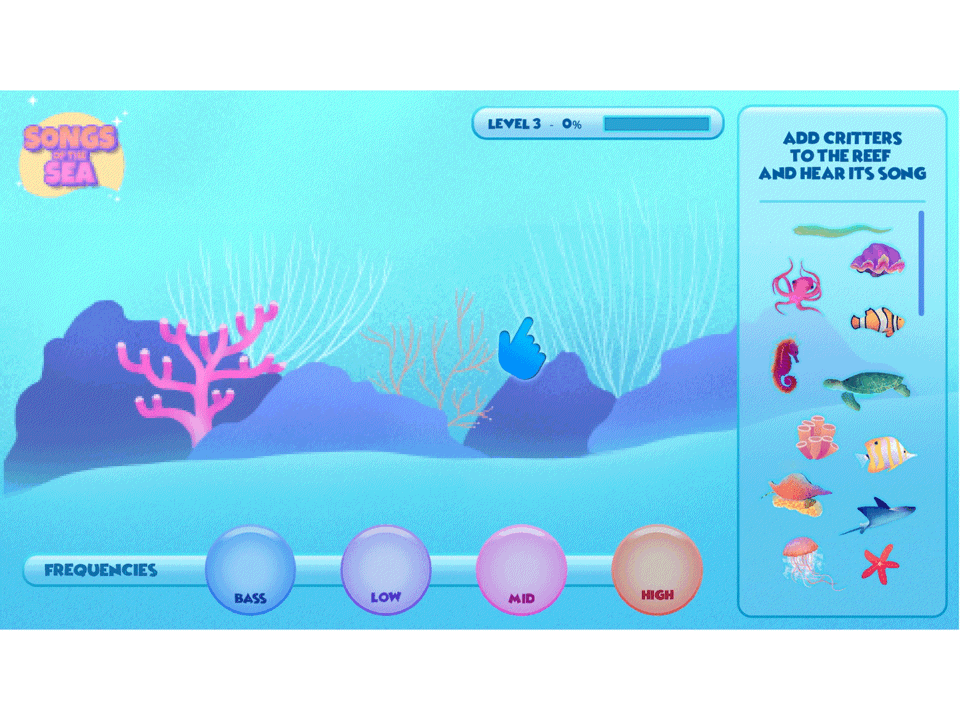Songs of the Sea
UX Designer | Team of 5 | 2023


Srishty Bhavsar, Jamie Espinosa, Bea Maggipinto, Alex Wang, Harvey Zheng
Description:
'Songs of the Sea' offers a unique fusion of ocean ecology and music. Ideal for students in middle school, and high school, the game introduces essential lessons about the interconnectedness of sound and ecosystem health. By merging our passions for environmentalism and music, we aim to educate players on the profound impact of sound on the delicate balance of marine ecosystems.
At the core of our game is conveying the concept that the well-being of ecosystems is intricately tied to the sounds they produce. Our focus on marine ecosystems aims to dispel the misconception that oceans are silent realms. Inspired by the research of scientists like Tim Lamont, a biologist specializing in audiology within coral reefs, we discovered the profound role sound plays in the vitality of these ecosystems. Lamont's work, such as reviving coral reefs by exposing them to the sounds of healthy reefs, underscores the crucial link between sound and ecosystem health.
The game's narrative is rooted in these discoveries, presenting players with a novel understanding of the ocean's ecosystems. Moreover, as oceans play an increasingly vital role in combating climate change, fostering ocean literacy becomes paramount for engaging audiences in their conservation efforts.
Delving deeper into our educational goals, 'Songs of the Sea' invites players to grasp the communication methods of underwater creatures, emphasizing their reliance on specific sound frequencies. Through gameplay, players not only explore marine environments but also gain an understanding of sound frequencies, fostering empathy and an appreciation for the intricate ways in which these creatures interact.
Play the game demo here!: Songs of the Sea

Competitor Analysis of 5 Educational Games within a similar domain
A Game Worth Making:
Recognizing its novelty and its limited presence in common knowledge, we aimed to highlight the relationship between health and sound in ecosystems, especially with oceans playing a vital role in combating climate change. As a result, promoting ocean literacy becomes crucial for audiences engaging in safeguarding our oceans
By consulting with Tim Lamont, we gained valuable tips and accessed a database of marine critter sounds. Using this database and clips sourced from divers and biologists, we compiled the necessary creature sounds categorized by frequencies (high, mid, low) and quality (harmony, melody, rhythm, bass). Initially, we organized our sound system based on quality parameters, assuming familiarity for non-musical players. However, we later revised it to focus on frequencies, aligning with underwater animal communication. We acknowledge the need for further sound design refinement for clearer representation.
Notably, the sounds we've created are musical but not naturalistic. Despite being based on categorization, we faced challenges in finding sounds for all creatures. For some, inaudible sounds or a lack thereof led us to create sounds based on physical characteristics or movements.

Analysis/Assignment of Sound Qualities to Underwater Creatures
Learning Principles:
Through 'Songs of the Sea,' our game seamlessly integrates metacognition, temporal contiguity, and active preconceptions to achieve our educational objectives.
Metacognition - Empowers players to explore and decipher the mechanics behind each level, encouraging them to discern what triggers progress, such as understanding the traits of different sounds that contribute to the progress bar.
Temporal contiguity - is showcased through the relationship between sound and organisms. Adding creatures to the scene introduces new sounds to specific categories, illustrating how multiple animals collaborate to enrich the track. This aids in grasping how diverse animals in an ecosystem harmoniously work together.
Active preconceptions - Leverages the familiarity of biology and music theory within our target audience. By merging these disciplines, we facilitate understanding the symbiotic relationships in ocean ecosystems through sound. Players, already equipped with basic biological knowledge and an ear for various sound types, can discover the health of symbiotic relationships in the ocean through this unique amalgamation of concepts.
Ideation
Our ideation process eschewed formal runs in favor of open discussions, fostering a collaborative exploration of ideas among team members. The focus was on cultivating a shared interest in the convergence of ocean ecosystems and music.
Identified Gap
A strategic analysis of existing products in the niche provided insights. While many games showcased abstracted sounds and ocean aesthetics, a gap emerged—few prioritized educational depths or aimed at creating a transformative experience centered on understanding underwater ecosystems and the role of sound.
Bridging Learning and Experience
The ideation phase honed in on creating a transformative experience, emphasizing the intricacies of underwater ecosystems and the significance of sound. Learning goals were identified, laying the foundation for a purposeful and engaging game.
Prototyping & Refining the Concept
To solidify our path, we delved into prototyping, exploring options, and evaluating their efficacy in meeting our design and educational goals. This iterative process allowed us to fine-tune our vision for a compelling and educational final product. Critical decisions arose regarding the game's organization—whether to focus on music theory or the communication dynamics of sea creatures. This pivotal stage required thoughtful consideration to align design choices with our overarching educational objectives.
Lo-Fi Prototypes
Lo-Fi Prototype #1
Our initial prototype, a sound sequencer where each creature contributed to a collective song, considered organizing the game around sound rather than ecosystem presentation; however, we opted against this approach to maintain a strong focus on exploring ocean ecosystems through both art direction and educational content, with the primary game mechanic centered around this concept.

Sound Sequencer with Associatied Sounds
Lo-Fi Prototype #2
Developed concurrently with the prior iteration, a drag-and-drop paper prototype showcased the player-game interface, exploring the concept of placing sea creatures within the environment to generate a symphony of sounds. This iteration also delved into organizing information, categorizing sea creatures into sonic elements (Rhythm, Melody, Harmony, Bass) with visual indicators for level progression. Opting for the second prototype's intuitive interactions and design prioritizing the ocean ecosystem scene, we continued refining elements to align with our educational goals.

Paper Prototype of Game Interface
Mid-Fi Prototype
Mid-Fi Prototype #1
In this phase, we transitioned the paper prototype to a digital Figma version, demonstrating drag-and-drop functionalities. A pivotal design decision merged abstract visual buckets with associated creatures, while we experimented with a rotating set of sea creatures, introducing a rotation in sets of three for each new placement. Recognizing screen space constraints, we opted to separate bubbles and sea creatures, streamlining the interface by consolidating multiple inventories into a unified one.

Mid-Fi Prototype 1
Hi-Fi Prototypes
Hi-Fi Prototype #1
In this iteration, a significant shift involved visualizing the game's actualized form, leveraging progress on art assets to gauge audience reception. The interface tested the concept of a rotating inventory and multiple bubbles organized by sound. However, this approach detracted from the backdrop scene, impacting the visibility of sand-residing sea creatures. A key consideration emerged regarding the representation of creatures—whether presented collectively or through a filtered feed for player input. Subsequent iterations aimed to address and refine these aspects.

Mid-Fi Prototype 1
Hi-Fi Prototype #2
In this iteration, we presented a streamlined design featuring only bubbles. To add elements to the scene, users would swipe to access the full inventory. Notably, we shifted from a language of song elements to frequencies, aiming to enhance players' comprehension of the game's objectives.

Mid-Fi Prototype 1
Hi-Fi Prototype #3
During the asset finalization for Unity development, we generated numerous elements for our interface design. In this iteration, we visualized the ultimate scene at the game's conclusion. Recognizing an overly busy interface with distracting elements, we sought to streamline the design to ensure a focused player experience on the main gameplay—the scene.

Mid-Fi Prototype 1
Final Design
Final Game Design
Our overarching concept for the game involves players enhancing an ocean ecosystem by adding animals, with each addition contributing a new sound to the evolving music, forming a song. The core gameplay loop revolves around adjusting the animal composition to achieve a balanced song, while also managing the distress of animals due to environmental factors like food scarcity or excessive noise. The outer gameplay loop mirrors puzzle-based games' progression, introducing complexity in each level. Additionally, players gain insights into ecosystem balance, exemplified by a "distressed animals" feature highlighting the consequences of imbalance. To avoid a god-like control dynamic, we aim to grant agency to the animals, allowing them to react and adapt, although this feature is a work-in-progress not fully demonstrated in the prototype.

Demo Gameplay
-1.png)
User Journey Map
Game Tutorial Demo
Art Direction
We wanted the overall experience of the game to feel relaxing, pleasant, and positive. We therefore decided on an art direction that would be colourful and playful. We went for a modern color palette and a type of illustration that is quite hand-drawn. We started with building a visual mood board and trying out different illustration styles:

User Journey Map

Game Tutorial Demo